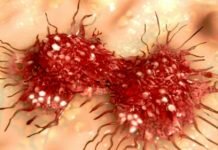
For many people living with life-limiting and life-threatening diseases like cancer, medical cannabis has long been hailed as a gift, both for symptom control and for its potential to limit the disease process itself.
But especially in the case of breast cancer—or, more accurately, breast cancers—the therapeutic potential of cannabis also comes laden with the potential for harm, and, like all medications, patients need to understand that powerful drugs can create unanticipated interactions with other powerful drugs.
This may be the case with cannabis and tamoxifen.
Kristin Wohlschlagel, R.N., a Hospice and Oncology Nurse who is a fierce patient advocate with a passion for investigating and educating about the evidence surrounding cannabis and cancer, recently broke down some of the most recent evidence and issues in a recent interview.
“New and emerging research from the past several years reveals that tamoxifen, and other Selective Estrogen Receptor Modulators, or SERMS, bind not only to estrogen receptors. They also bind with high affinity to one or both cannabinoid receptors, for CB1 and CB2,” said Wohlschlagel. “Tamoxifen apparently binds to both receptors, as what is called an ‘inverse agonist.’ The possible effects caused by that binding are just beginning to be explored.’”
Breast Cancer: Not Just One Disease
Unlike most forms of cancer, “breast cancer” is actually a blanket term rather than a single diagnosis. It covers several distinct types of cancer that are further distinguished by diagnostic laboratory tests. The specific diagnosis drives individual considerations among patients and their medical teams regarding which treatments are most likely to produce the optimaloutcomes for each patient.
- Estrogen-receptor positive or negative (ER+ or PR-): Roughly 80% of breast cancer cells tested in labs are positive for estrogen receptors, which means estrogen may support and fuel the cancer’s growth. The remainder are estrogen-receptor negative.
- Progesterone-receptor positive or negative (PR+ or PR-): In addition to receptors for estrogen, tumors may also have receptors for progesterone. About 65% of breast cancers are both ER+/PR+, while 13% are ER+/PR-, 2% are ER-/PR+, and a final 25% are ER-/PR- (receptors for neither estrogen nor progesterone).
- HER2 status: Human epidermal growth factor receptor 2, or HER2, is a gene that plays a role in about 25% of breast cancers. The gene malfunctions, creating too many copies of itself, which ultimately makes HER2-positive breast cancers grow and spread more rapidly than other types of breast cancer.
- Triple-positive: With receptors for both estrogen and progesterone as well as overexpression of the HER2 gene, triple-positive breast cancer has more conventional treatment options than others.
- Triple-negative: These breast cancers do not show receptors for estrogen, progesterone, or HER2 gene overexpression. Because of this lack of receptors, this type of breast cancer is difficult to target with hormones or drugs that target HER2.
Tamoxifen, Hormones, Receptors, and the Immune Response
Tamoxifen is the oldest and most widely used of a class of drugs called Selective Estrogen Receptor Modulators (SERMS). Tamoxifen and other SERMS are commonly prescribed for women with hormone-sensitive breast cancers as one option to attempt to control the growth and spread of the cancer. The intended benefit is to block the estrogen receptors and to interfere with circulating estrogen’s ability to bind and stimulate the tumor cells.
Tamoxifen is a “pro-drug,” which means it is not fully effective until it is metabolized by the liver into its more potent anticancer form through a specific enzyme and metabolic pathway. This metabolic process can be interrupted, inhibited, or even entirely blocked by other substances, both common and uncommon–including large doses of cannabis.
Grapefruit?
Perhaps the most common food-drug interaction that many people are already familiar with from warning labels and their own physicians is the grapefruit interaction; many pharmaceuticals come with specific warnings not to take them with grapefruit, because grapefruit contains enzymes that inhibit CYP450 metabolism. Tamoxifen is one of these drugs. And cannabinoids, like grapefruit, are known to inhibit CYP450 metabolism.
To date, it appears that THC is mostly metabolized and inhibits the metabolism pathways CYP2C9 and CYP3A4. CBD is reported to be mostly metabolized via and inhibits the pathways CYP2C19 and CYP3A4. CBD appears to inhibit at least CYP3A4 more significantly than THC. But more research is needed to begin to clarify what constitutes a small or large dose. Individuals will also learn that they may metabolize certain medicines and foods differently due to genetic variations affecting metabolism.
“Because grapefruit is a commonly-encountered food that is famous as a CYP450 inhibitor, which should not be used with some medications, I often use it as a surrogate for CBD and THC to check for potential drug interactions,” says Wohlschlagel. ”Due to the historic lack of research on cannabis, we do not have a wealth of research on its potential drug-drug interactions. But when I educate patients, I tell them to check for grapefruit interactions on trustworthy pharmaceutical websites like WebMD. There, they will see that using tamoxifen with grapefruit—and, we must conclude, large doses of cannabinoids as well—could risk reducing the hormone-blocking effects of tamoxifen for breast cancer patients. This could be critical for their outcomes.”
Other drugs metabolized through the same pathways, including popular antidepressants like Paxil, are also on the list of drugs to avoid while taking tamoxifen.
It’s well-known that many forms of cancer respond positively to the anti-proliferative (anti-growth) properties of THC, which binds to cannabinoid receptors in tumors and causes them to stop growing or even to shrink. But a 2015 European studyfound at least 20% of breast cancer biopsies samples examined did not over-express any CB2 cannabinoid receptors, even in low numbers. There will also likely be various individual tumor mutations that can potentially cause resistance to the effects of THC, as can happen with any therapy. That means the potential benefits of cannabis for treating breast cancer are not as cut-and-dry as oversimplified “natural healing” blogs and headlines sometimes imply. Most patients are using cannabis medicines integrated with conventional therapies.
In fact, in addition to possibly interfering with hormone-suppressing activity of tamoxifen, larger doses of THC can also suppress the body’s T-cell proliferation, which is a part of the immune system that is critical for tumor cell growth suppression. In these cases, the use of high-THC forms of cannabis could theoretically not only not help, but could also make matters worse, allowing the tumor cells to grow more rapidly.
Medical Guidance is Critical
Only a patient’s physician and medical team can offer individual medical advice. If a breast cancer patient feels strongly that cannabis is important to use, those who have been prescribed tamoxifen should be forthright, up-front, and completely honest with her (or his) physicians about using cannabis – especially because the most beneficial amounts of THC and CBD could be quite different depending on the diagnosis.
Small doses of cannabis medicines used are much less likely to cause any significant drug interactions, but some patients are using doses much higher than historically common. Because CBD-rich medicines will not cause as much psychoactivity, people can easily use large doses (75 mg CBD per day or more) without feeling any significant side effects. While large doses may be considered generally safe, the potential for side effects and potential interactions with other therapies is increased at these levels.
Tamoxifen and SERMS
Someone taking tamoxifen or one of the other SERMS needs to understand that there may be some risk of drug-drug interaction, including a possible competition for cannabinoid receptors by the SERMS. This could potentially reduce the effectiveness of the cannabis medicines.
Because large doses of cannabinoids like CBD and THC can inhibit metabolism or processing of substances by the liver, reviewing this potential with your healthcare team is important.
There are alternatives to Tamoxifen which are effective and considered “standard of care” by oncologists. One of the main alternatives is to suppress the ovarian function, including estrogen production, using injectible medications such as Lupron or Zoladex. Again, this is a matter to review and discuss with a comprehensive health care team. Managing the hormonal aspect of most breast cancers can be crucial to treatment.
The Importance of Informed Medical Guidance
Above all, Wohlschlagel is a fierce and outspoken advocate for women and men who are living with and through the constellation of diseases we call “breast cancer.” And while she recognizes that there is a place in the treatment regime for cannabis for many of them, she also wants to emphasize that it is not a panacea, and it is not a cure-all.
“There is not enough evidence-based, scientifically sound information available for patients to do this on their own,” she says. “It’s impossible to fully address the pros, the cons, the potential for benefits and the potential for harm in a blog post or on a Facebook page. There are multiple potential drug interactions that could leave any single patient better or worse off. It is critically important to get a medical team who understands the implications of cannabis and breast cancer on board. I’ve interviewed young women with hormone-positive breast cancer who have reported doing poorly when they tried to use high doses of THC—their disease advanced rapidly, sometimes in a matter of weeks. Some reported that they were also using tamoxifen during that time. Did the tamoxifen interfere with cannabinoid actions? Or did the tamoxifen metabolism get reduced by the large doses of THC they were taking? Since they reported they had been using 100 or more milligrams of THC each day, it is impossible to know for certain. But it certainly raised my awareness of the potential issues that patients may experience.”
“How this is all interacting is a question that will take time to clarify,” she says, “and more research is urgently needed. Then there’s another factor: All tumors can mutate or change when it is treated or spreads, which can change the efficacy of all medications, even when they have been previously helpful. Close monitoring with scans or tumor markers of cancer status is very important, possibly including genomic reassessment of the tumors over time. We are thankfully getting much closer to precision or personalized therapies for many forms of cancer. Unfortunately not all patients and doctors realize how rapidly genomic testing is changing cancer therapy choices, potentially opening up treatment options customized to their unique needs.”
Beyond Tamoxifen: Cannabis and Aromatase Inhibitors
For women (and men) with breast cancer who are not taking tamoxifen—those who are post-menopausal, are using ovarian suppression medications, or who have no ovaries—a physician may prescribe an aromatase inhibitor (Arimidex, Aromasin, or Femara) to help reduce estrogen produced in body tissues other than ovaries. Wohlschlagel says some of these appear to be significantly safer to use with cannabis extracts because they are not metabolized in the same way as tamoxifen, and they do not appear to bind with CB1 and CB2 receptors, leaving those potential targets open for THC to bind to. However several of those (one example is Arimidex) also may be impacted if taken along with strong inhibitors of the CYP3A4 enzyme pathway, such as large doses of CBD and THC. Please speak to your doctor or pharmacist about this.



